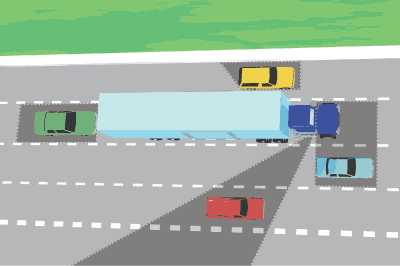To reduce the chance of having a collision with a large truck or RV, you must be familiar with a big rig’s physical capabilities and how it maneuvers.
Large Trucks Take Much Longer To Stop
Large trucks take longer to stop than vehicles traveling at the same speed. The average passenger vehicle traveling at 55 mph can stop within 400 feet. However, a large truck traveling at the same speed can take almost 800 feet to stop. Do not move in front of a large truck and suddenly slow down or stop. The trucker will not be able to stop quickly enough to avoid crashing into you.
Trucker’s Blind Spots – The “No Zone”
Shaded areas are the driver’s blind spots.

Passenger vehicle drivers incorrectly assume that a trucker can see the road better because he or she is higher off the road. While truckers do have a better forward view and bigger mirrors, they still have large blind spots and your vehicle can get lost in those blind spots. If you stay in those blind spots, you block the trucker’s ability to take evasive action to avoid a dangerous situation. Generally speaking, if you cannot see the truck driver in his or her side mirror, he or she cannot see you. These blind spots are often called the “NO ZONE.”
Large Vehicles Make Wide Turns
When a vehicle makes a turn, the rear wheels follow a shorter path than the front wheels. The longer the vehicle, the greater the difference in the turning path. This is why big rig drivers must often swing wide to complete a right turn. When you follow a big rig, look at its turn signals before you start to pass. If the truck appears to be turning left, check the turn signals again; the driver may actually be turning right but first swinging wide.
Maneuverability Of Large Vehicles
Trucks are not as maneuverable as passenger vehicles. Large trucks have longer stopping and starting distances. They take more space for turns and they weigh more. When no signs are posted, these vehicles must be driven in the right hand traffic lane or as close as possible to the right edge of the roadway. On a divided highway with four (4) or more traffic lanes in one direction, these vehicles may also be driven in the lane just to the left of the right hand lane.
Avoid these mistakes when driving around large trucks:
- Cutting off a truck in traffic or on the highway to reach an exit or turn. Cutting into the open space in front of a truck is dangerous. Trying to beat a truck through a single-lane construction zone, for example, removes the truck driver’s cushion of safety and places you and others in danger. Slow down and take your turn entering the construction zone. Do not speed up to pass a truck, so you can exit the roadway. Take a moment to slow down and exit behind a truck—it will only take you a few extra seconds.
- Lingering alongside a truck when passing. Always pass a large truck on the left side, and after you pass the truck, move ahead of it. Do not linger. Otherwise, you make it very difficult, if not impossible, for the trucker to take evasive action if an obstacle appears in the road ahead.
- Following too closely or tailgating. When you follow so closely behind a truck that you cannot see the truck driver’s side-view mirrors, the trucker cannot see you and has no way of knowing you are there. Tailgating a truck, or any vehicle is dangerous because you take away your own cushion of safety if the vehicle in front of you stops quickly.
- Underestimating the size and speed of an approaching tractor-trailer. A large tractor-trailer often appears to be traveling at a slower speed because of its large size. Many collisions involving a passenger vehicle and a large truck occur at intersections when the passenger vehicle driver did not realize how close the truck was or how fast it was traveling.
